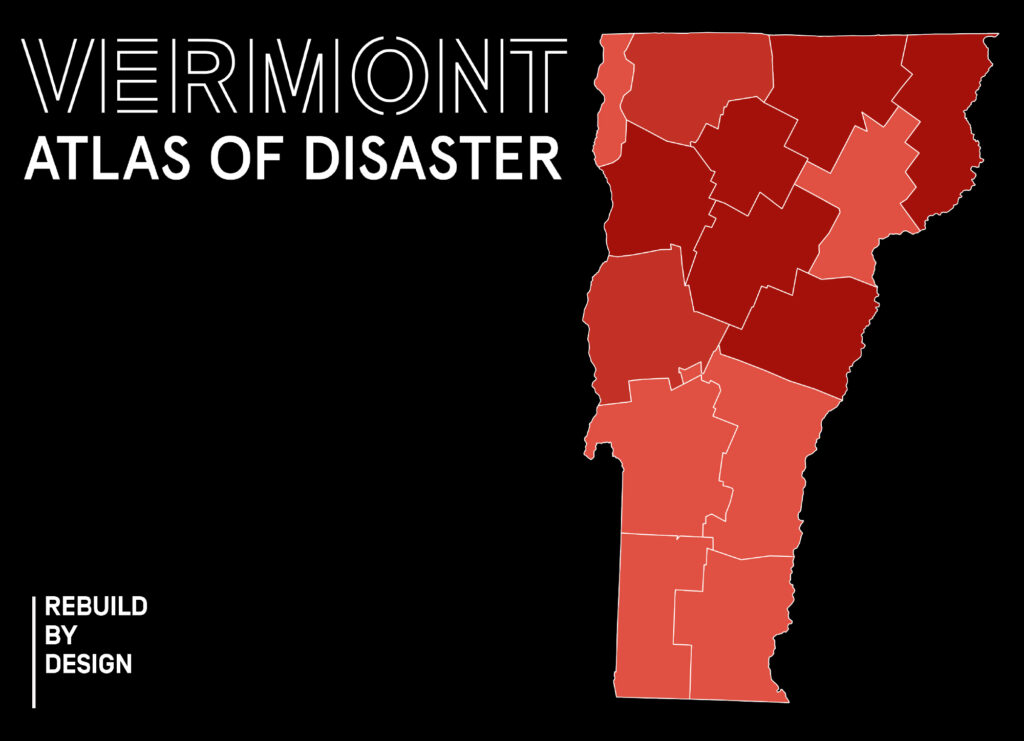August 3, 2023 – As Vermonters continue to clean up from the latest flooding, Rebuild by Design, a nonprofit working on climate adaptation infrastructure globally, releases the report “Atlas of Disaster: Vermont” which identifies the impacts of recent climate disasters across Vermont at the county level. The data shows that Vermont had 17 federally declared disasters for climate events for the years 2011-2021, affecting every single county in Vermont – tying with Texas, Alabama, and West Virginia for the 7th highest across the United States in the frequency of climate disasters.
Between 2011-2023, residents of the Green Mountain State have borne the impacts of severe floods, tropical storms, and winter storms. Washington County has had the most disasters during that time (11) and forty percent of counties have had ten or more federal disaster declarations. Windsor County has received the highest total federal post-disaster assistance (FEMA Public Assistance and Hazard Mitigation Assistance) within the state. The state received a total of $370 million federal post-disaster assistance for those years – ranking fifth in per capita spending in the United States.
Rebuild by Design released an analysis of county-level data to capture the reality that Vermonters are living through. “Atlas of Disaster: Vermont” includes eight maps that show where major disasters have occurred, where post-disaster support has been allocated, where the most socially vulnerable populations reside, and the energy reliability by utility area. It also provides county-level disaster data within State House and Senate district boundaries so legislators and their constituents can work together to advocate for the adaptation needs of their communities.
The impacts of storms and flooding disproportionately affect the most vulnerable people. Disasters are not created by natural events alone; rather, they are the product of natural events and a combination of social, political, and economic stressors. Therefore, as climate change increases the frequency of flooding, it will further reinforce underlying vulnerabilities and systemic inequality.
“This data unequivocally shows that for every Vermonter, no matter where they live, climate change is here,” said Amy Chester, Managing Director of Rebuild by Design. “Every day that we are not investing in adapting Vermont’s infrastructure to current and future climate conditions, we are actively working against our own pocketbooks. We can do better.”
Rebuild by Design, brought on the expertise of APTIM and iParametrics to take a county-by-county look at the rate of federal disaster occurrences and the costs of extreme weather in the United States. This data is included in the national report Atlas of Disaster, which has a nationwide scope, to provide a more in depth look at the impact of climate disaster across the United States. The data represents a conservative estimate of the toll of extreme weather events, as data in the report does not include state-declared disasters, state post-disaster assistance, private spending, or additional funding that comes after a storm, such as loans, insurance payouts, or private philanthropy.
“Extreme weather events are affecting all Vermont communities causing significant economic and social hardships,” said Jeff Stevens, Executive Vice President at iParametrics, “Vermont needs to focus its efforts on proactive hazard mitigation solutions, especially when rebuilding from recent flooding.”
This report informs our understanding of the impact of climate events on communities throughout Vermont while also highlighting the need for further state-specific data collection to understand the true impact of these events. It calls for Vermont to create a new long-term funding source to support climate adaptation infrastructure – to reduce the physical, economic, and social tolls of future extreme weather events, support communities looking to move away from risky areas, and protect and restore the natural environment. The fund could be supported by a surcharge on certain types of insurance, a state-level “Climate Superfund.” State funding could also leverage additional federal funding by providing a local match for programs that will be made available under the Inflation Reduction Act and other federal sources.
“Increased funding at the State level will make it easier for localities to draw down federal infrastructure funds and will help the United States get ahead of the next storm instead of always fighting the last one,” said Dr. Paul Tschirky, Senior Director of Resiliency at APTIM.
The Vermont report builds on the 2022 report, Atlas of Disaster, which found that 90 percent of U.S. Counties had a federal disaster declaration between 2011-2021, with a conservative cost of $91 Billion in FEMA and HUD post-disaster assistance (taxpayer dollars). However, investing in preventative measures saves money and lives. The report found that Vermont alone could support $600 million in investments into resilient infrastructure with a small insurance surcharge. According to the National Institute for Building Sciences, every dollar invested in pre-disaster infrastructure (mitigation) can save as much as $6 – costs that taxpayers would otherwise shoulder.
Nationally, in 2022 alone, there were 18 climate disaster events with losses exceeding $1 billion each. In order to achieve true community resilience ahead of extreme weather events, the report calls for a complete overhaul of the systems that have long left us playing catch up after climate events. Programs such as FEMA’s Individual Assistance, Public Assistance, Hazard Mitigation Assistance, HUD’s Community Development Block Funding Disaster Recovery, and loan programs are only available after an extreme event. The United States must shift those investments ahead of storms to build the infrastructure we need to adapt to climate change – before communities suffer.
“Extreme climate events mean life or death to the most vulnerable communities,” said Amy Chester, Managing Director of Rebuild by Design “Vermont is experiencing more drought, more flooding, and more extreme weather. Each moment that we delay action towards a solution contributes to a higher cost to our lives and livelihoods.”
